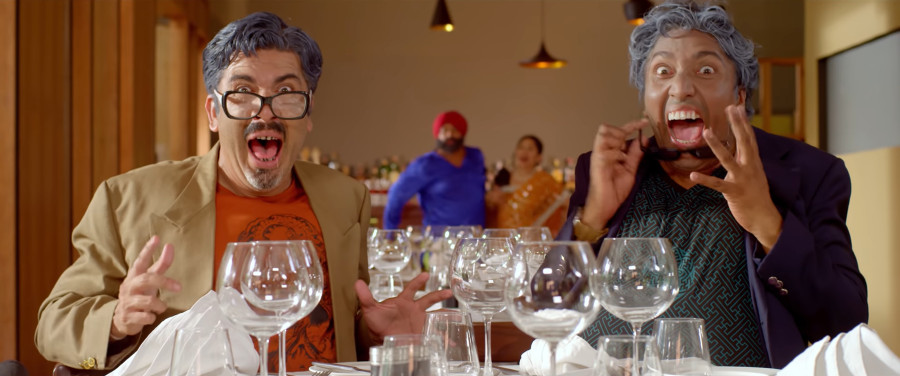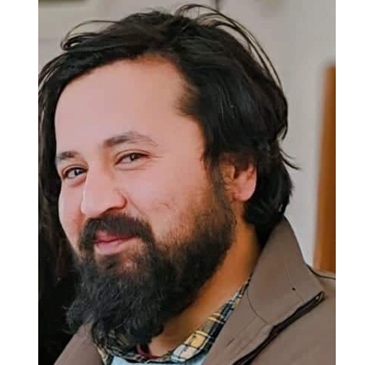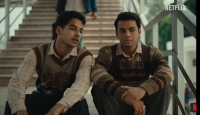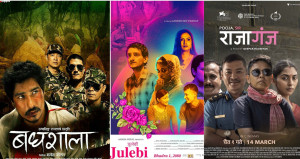Movies
Na Eta Na Uta: an insensitive bully of a film masquerading as a comedy
The latest Nepali film proves that filmmakers still underestimate their audience’s intelligence. And judging from the audience’s reaction in the cinema hall, we’ve had enough.
Abhimanyu Dixit
I don’t remember watching such a parade of over the top characters in a single film since the time of Govinda and Johnny Lever movies. Remember when one actor would do 10 different characters? This film is a harsh reminder of those days. I cannot fathom how someone can take the time and energy to write character descriptions like Shyam and Harry—middle-aged, colourful (half) pantsuit-wearing men with bad hair and decaying teeth, who are fast approaching their “expiry date.” Yet this is exactly what our lead characters are in Na Eta Na Uta, the latest Nepali wannabe comedy.
With this film, I’ve come to the conclusion that Nepali comedy writers, especially in visual media, are bullies. Over time, they’ve proved themselves to be sadists too. They derive laughter from cheap tropes, making fun of people’s weight, height, skin colour, language and tone. Forgo nostalgia for a moment, and remember Hari Bansha’s excess makeup of his characters, where the sole intention was to laugh at those who defy conventional beauty. Remember the hard of hearing character who misinterprets words. Remember how we laughed at the cost of their disability? Remember Santosh Panta’s blackface representation of a Madhesi character? This culture of shaming is still very alive in Nepali films. Blackface is ardently overdone by Sandip Chhetri (on Kantipur TV). Sitaram Kattel and Kalpana Ghimire (Dhurmus and Suntali) want us to laugh at characters with mental disabilities in Meri Bassai (Nepal TV).
And this film Na Eta Na Uta is a byproduct of this bullying culture. And judging from the audience’s reaction in the cinema hall, we’ve had enough.
Shyam (Miraz Roshan) and Harry (Sameer Dixit) are middle aged, pot-bellied, horny men from London desperate to get married. There is no logic as to why they’re designed this way, as almost everything about them is nonsensical. But why they are desperate for marriage is given an answer: they want it for sex, or for ‘suhaag-raat’, which is the censor-passed equivalency for sex in Nepali and Indian films.
To make marriage a reality, Shyam and Harry meet Sara (Loonibha Tuladhar), their matchmaker. The men, however, have a hard time finding a suitable bride. They complain how Sara suggests women who’re ‘monkey faced’, and while at it, they also poke fun at Sara for being single herself. This casual sexism and bullying comes in the first 10 minutes of the film, and what follows is worse.
Keeping aside the internalised misogyny, these are ‘heroes’ in the film who try to inject into you a random bout of patriotism. But sadly, the makers can’t get this right either. In one scene, the men are seeing hurling cake and food items at a person—a Punjabi—who insults Nepal. There is also a callback to this random patriotism later through a song sequence where the lead actors adorn dhaka topis atop a London tour bus. Of course, only people from the hills (30 percent of Nepalis) wear dhaka topis, but the filmmakers seem to think that’s a tool to garner claps and evoke patriotic sentiments.
Moving on, Shyam and Harry are sent home for inciting violence, and when they reach Nepal (with an airport exit scene the two meet a plethora of characters in a lethargically repetitive first half), despite their many efforts to be liked, the people here shun them because they’re not physically appealing.
Bibek (Kiran Rai) suggests a makeover for the two: to turn the two from ugly parodies to ‘Nepali heroes’. They agree. They fix their teeth from dirty and crooked to straight and clean, colour their hair from grey to black, lose weight, also meet a sex doctor for the sake of some double entendres. I am not sure if the above list is in the order the film presented it in, but it wouldn’t make any difference anyway. It’d actually be better if you rearrange these scenes, or delete them altogether and rush to the end.
Also, all of the mentioned roles—the dentist, beautician, trainer, sex doctor—are played by one actor, Rajaram Poudyal, in different prosthetic makeup. Remember the roles Govinda, Johnny Lever, and Kader Khan made famous in the ’90s? Anyway, the whole ordeal turns Harry and Shyam into traditional South Asian heroes: middle aged, lean(ish), and ready to romance girls who’re a lot younger.
The dialogue and screenplay are penned by Abhimanyu Nirabi and Miraz Roshan respectively, with the latter also being the co-director. While Roshan repeats scenes, Nirabi repeats dialogues. You will be amazed at the number of times the words ‘London’, ‘pet’ (belly), ‘teeth’, and ‘girls’ is mentioned in the first half alone. Judging from his past works, it seems Nirabi’s go-to formula to write dialogue in Nepali films is using double entendres and disgusting jokes. He gets around three scenes to exercise his style of writing and aces all of them.
The film doesn’t delve into its plot until the interval, when Bibek dies and Harry and Shyam—for some reason unbeknownst to the audience—blame themselves. Heeding to a grieving father’s request, they’re now living in Bibek’s home. Here, they see Maya (Chhulthim Gurung) and her friend Kaali (Reecha Sharma). Almost immediately, the death of a family member is forgotten, and the movie breaks into a love song, with Shyam and Harry dancing with Maya and Kaali (who have become their significant others by this point). The film that began as middle-aged men looking for sex turns into a safe romantic comedy.
Of course, the audience remains indifferent. We never empathise with anyone nor do we care for their love stories. We never care for the characters because they’re all loud caricatures designed to be laughed at. This brings me to a particular character—Kaali, who is named thus for the colour of her complexion. I have a 10-year-old nephew who knows better, that it’s insensitive to have nicknames that are derogatory and pick on your physical features, such as ‘Kaali’ or ‘Moti’ or ‘Pudki’.
The film is so badly made that the fairly interesting third act is easily overlooked. Here, the attempt is to sum up the entire film and it’s done quite interestingly, with the various characters that were established in the first half coming back to help the heroes in reaching their goal.
There is, however, one more thing that deserves a mention: this movie is one of those rare movies where middle-aged men are playing lead roles. The issue the movie tries to deal with—of middle-aged men trying to get married—is unique, but the design of the characters (or lack thereof) and their presentation is absolutely appalling, which sadly hurts the issue rather than help it.
With this movie, I came to the sad realisation that Nepali filmmakers still underestimate their audience’s intelligence. Why else would they think people would buy into a ’90s Bollywood film that masquerades as a 2019 Nepali comedy? With multiple screening options available in cinema halls and the internet, the audiences today have unlimited world-class cinema at their disposal. Makers should never forget that the audience doesn’t need to watch Nepali films. And it’s going to take a lot of homework, actual effort into story writing, and better acting to make audiences want to watch Nepali movies.
NA ETA NA UTA
Stars: 2 out of 5
Actors: Miraz Roshan, Sameer Dixit, Reecha Sharma, Chhulthim Gurung
Directors: Miraz Roshan, Bisharad Basnet
Writers: Miraz Roshan, Abhimanyu Nirabi
***
What do you think?
Dear reader, we’d like to hear from you. We regularly publish letters to the editor on contemporary issues or direct responses to something the Post has recently published. Please send your letters to [email protected] with "Letter to the Editor" in the subject line. Please include your name, location, and a contact address so one of our editors can reach out to you.




 13.12°C Kathmandu
13.12°C Kathmandu











%20(1).jpg&w=300&height=200)

